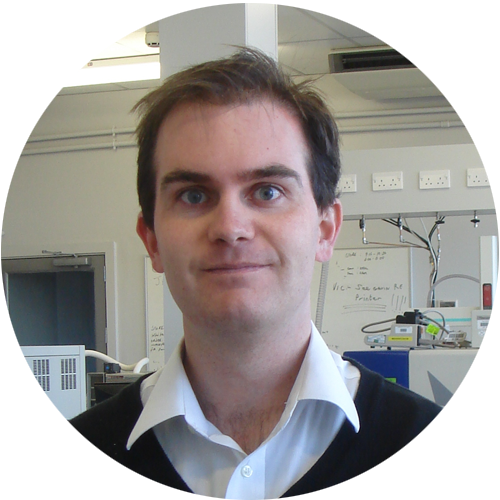TLC/CMS, the atmospheric liquids and solids probe (ASAP), and the volatile APCI source provide direct analysis without sample preparation – even for air-sensitive compounds.
With the daily need to analyze a variety of samples, these techniques are indispensable in a busy lab.
Learn how a single instrument can be adapted to each of these sample requirements and rapidly changed to accommodate back-to-back assays. Listen to users in the field speak about the innovative sample inlets that have cut down on sample prep and streamlined their everyday work flow.
During this webinar you will:
- Learn how the CMS offers real-time results and decision making right at the bench. This allows chemists to optimize reactions, know when to quench, and know when they have failed and to move on
- Learn several novel sample techniques that can streamline workflow in your lab
- Find fast analysis methods for liquids, solids and vapor-phase compounds
Hear from leaders in mass spectrometry including:
- Dr. Jack Henion, Advion Scientific Founder
- Matthew Turner, Experimental Officer in Mass Spectrometry, Department of Chemistry, Loughborough University
- Tao Yongfeng, Post Doctorate, The Romo Group, Baylor University
- Sean M. Kerwin, PhD, Associate Professor, Department of Chemistry & Biochemistry, Texas State University
Aim: Breath analyses have potential to detect early signs of disease onset. Ambient ionization allows direct combination of breath gases with MS for fast, on-line analysis. Portable MS systems would facilitate field/clinic-based breath analyses.
Results & methodology: Volunteers ingested peppermint oil capsules and exhaled volatile compounds were monitored over 10 h using a compact mass spectrometer. A rise and fall in exhaled menthone was observed, peaking at 60–120 min. Real-time analysis showed a gradual rise in exhaled menthone postingestion. Sensitivity was comparable to established methods, with detection in the parts per trillion range.
Conclusion: Breath volatiles were readily analyzed on a portable mass spectrometer through a simple inlet modification. Induced changes in exhaled profiles were detectable with high sensitivity and measurable in real-time.
From Bioanalysis, Published June 2016
Direct sample analysis of liquids, solids and powders without chromatography is as easy as it sounds, and provides mass spectral information within seconds. The video demonstrates analysis of a reaction mixture.
The inert Atmospheric Solids Analysis Probe (iASAP) allows easy sampling of air-sensitive compounds, such as metal catalysts and organometallics, from reactions that are carried out in a glovebox or Schlenk line.
Quant Express, an addition to Advion’s user-friendly Mass Express 4.0 software suite, features quantitation to create a fully integrated software system for expression CMS users.
The Loughborough University team has utilized the expression® CMS vAPCI source for a variety of applications including breath analysis, monitoring flavor and fragrance, plant metabolomics, food authenticity and spoilage, and microbiological monitoring. With the use of the expression® CMS, the team was able to successfully execute detection required for these applications quickly and easily.

Q: WHAT IS THE FOCUS OF YOUR LAB’S RESEARCH?
A: We investigate ionic systems to the fullest extent, both experimentally and theoretically. In doing so, we want to understand and exploit the fundamental principles that determine the behaviour of such systems.
Q: WHAT WAS YOUR PREVIOUS WORK FLOW OR CHALLENGES?
A: For sample analysis we use NMR, vibrational Spectroscopy and X-Ray Diffraction along with electrochemical measurements in our laboratory. However, for mass spectra the samples had to be given to the MS service of the chemistry department. This led to noticeable waiting times, so no reaction monitoring was possible. Also, some of the compounds usually lead to large memory effects and are therefore rather ‘unpopular’ at the MS service. Furthermore, a large part of the compounds we synthesize are air sensitive and could not be measured at all.
Q: WHY DID YOU INCORPORATE THE EXPRESSION CMS INTO YOUR LABORATORY?
A: With the expression CMS in our laboratory we can now use mass spectrometry as a standard analysis tool for reaction monitoring. PhD Students can measure their own samples directly after synthesis. They can even change the ion source on their own according to the nature of their samples. Samples with large memory effect are no longer problematic, as the inlet capillary can easily be cleaned. A major advantage is that we can now analyse highly air-sensitive compounds without difficulty and outside a glove box.
Q: WHO WOULD YOU RECOMMEND TO PURCHASE THE EXPRESSION CMS?
A: We would recommend the expression CMS to anyone who wants to implement MS as a fast and easy to operate standard method within their own lab.
With decades of mass spectrometry and chemistry expertise, Advion Interchim Scientific has produced a family of compact mass spectrometers designed for the chemist. The affordability, small size and ease of use make them ideal for use directly at the chemist’s bench, giving immediate answers and informed decisions instead of waiting.
The Advion Interchim Scientific expression® compact mass spectrometer (CMS) is a fast and easy analytical tool for the organic chemist. Ideal for fast reaction monitoring, the expression® CMS features a single quadrupole that can adapt to multiple ionization sources in seconds, including both ESI and APCI. The mass spectrometer works in a variety of applications, including food and beverage, pharmaceutical, biomedical, peptides and proteins, drug discovery and more. The expression® CMS offers a variety of novel sampling techniques, including:
- Direct mass analysis of TLC plates in 30 seconds at the push of a button with Plate Express™
- One-touch analysis of solids and liquid samples with the ASAP® probe
- LC/CMS
- Many more options and configurations to suit your needs
Learn more about the different sample techniques available with the expression® CMS, including fast assay methods for liquids, solids, gases, and even air-sensitive compounds.
Fill out the form to download the full expression® CMS brochure now.

Q: WHAT IS THE FOCUS OF YOUR LAB’S RESEARCH?
A: My group specializes in developing new methods for pharmaceutical, metabolomic and security applications. In particular, this has involved the analysis of volatiles, either by direct analysis of breath, or through using thermal desorption to extract volatiles from solid or liquid matrices.
Q: WHAT WAS YOUR PREVIOUS WORK FLOW OR CHALLENGES?
A: Previously, we used a quadrupole time-of-flight instrument for volatile analysis. These instruments are not really designed with the analysis of small volatiles in mind and required preconcentration for breath analysis.
Q: WHY DID YOU INCORPORATE THE EXPRESSION CMS INTO YOUR LABORATORY?
A: The expression CMS offers excellent performance in the low m/z range and proved highly sensitive for determining volatile species in breath, requiring no preconcentration. Secondly, the instrument is transportable and can be deployed at the site of sampling giving high sample throughput and real-time measurements.
Q: WHO WOULD YOU RECOMMEND TO PURCHASE THE EXPRESSION CMS?
A: Anyone interested in volatile analysis would find the CMS an excellent instrument for targeted analysis.
Compact Mass Spectrometry for Fast, Quantitative VOC Screening
Breath analysis is a valuable and widely-used technique that is gaining popularity in medical diagnostics, sports science, substance abuse and other fields where immediate, reliable detection of a variety of in-vivo compounds and their metabolites is required.
However, the actual analysis can be complicated because of the type of data required, the need to sample directly from humans and animals, and the need for real-time access to proximate analytical equipment.
In this recent study by Loughborough University, breath was sampled directly from test subjects into Advion’s expression Compact Mass Spectrometer (CMS). The data collected during this pilot study was very positive and resulted in the go-ahead of a larger study of real-time breath profiling of a much greater population of subjects. Results were superior to those acquired by collection and concentration on TD tubes and then desorbing into large, expensive mass spectrometer systems costing more than 4 times that of Advion’s CMS.


